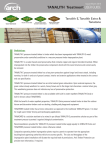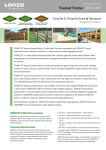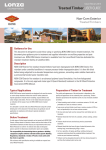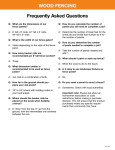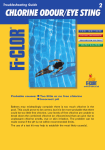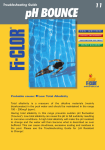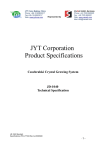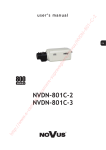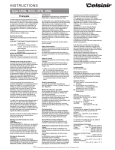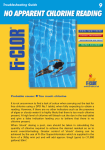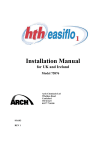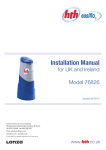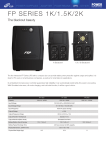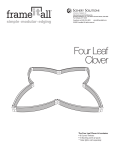Download Treated Timber USER GUIDE
Transcript
Issued May 2014 Treated Timber USER GUIDE Vacsol Aqua Treated Timbers VACSOL Aqua treated timber is timber which has been impregnated with VACSOL Aqua wood preservative under controlled conditions in a double vacuum, low pressure timber impregnation plant (VAC-VAC plant). VACSOL Aqua is a waterbased wood preservative that contains organic active ingredients (triazole fungicides and an insecticide). VACSOL Aqua treated timber gives long term protection against fungal and insect attack, for both interior and exterior (above ground contact) construction timber and joinery applications. VACSOL Aqua treated timber must only be used above the damp proof course level and/or above ground contact. Exterior joinery/woodwork must be subsequently protected with an appropriate and maintained surface coating. In termite areas, VACSOL Aqua treated timber should be used above the termite shield. The appearance of VACSOL Aqua treated timber following treatment is virtually unchanged. However, a colourant is often included to facilitate identification of treatment. Vacsol Aqua Wood Preservative Treated Timber Appearance VACSOL Aqua wood preservatives are approved for use by the relevant regulatory authorities in the markets they are used. The biocides contained in VACSOL Aqua wood preservatives are being supported under the Biocidal Products Regulation. After the application of VACSOL Aqua wood preservative by the VACVAC process, the appearance of the timber is virtually unchanged. However, a colourant is often included to facilitate identification of treatment. Treatment Specifications VACSOL Aqua treatment process parameters can be varied, taking into account timber species, desired service life and to match the end use (Use Class) of the timber. It is therefore extremely important that the end use and species of the timber are clearly stated within the treatment specification. Use Classes are defined in BS EN 335 2013 but can be summarised as follows: • Use Class 1 - internal building timbers - no risk of wetting. • Use Class 2 - internal building timbers - risk of wetting. • Use Class 3 coated - external timbers used above ground contact and coated. In accordance with EN 335:2013 Use Class 3 can also be sub-classified as 3.1 and 3.2 respectively. The interpretation of these sub-classes may vary from country to country. VACSOL Aqua treated timbers can be produced to meet the requirements of Use Classes 1, 2 and 3 coated. Experience has shown to date that there is no particular problem with grain raising. However, as with all water based products, there is potential for this to take place. Colour variations may occur due to the natural variability of the relative proportions of heartwood and sapwood and darkening of some hardwoods may occur. Trials should be carried out on decorative timber species (particularly hardwood species) to check any shade changes prior to treatment of the full commercial batch. Further information can be obtained from the Lonza Wood Protection Advisory Service. Post-Treatment Storage and Collection of Treated Timber When received, VACSOL Aqua treated timber should be free from surface liquid. Drying will be accelerated when stored in a wellventilated, weather protected area. Impregnation of timber with VACSOL Aqua imparts a low moisture uptake. This may cause slight swelling across the end grain surfaces. Treated Timber USER GUIDE Vacsol Aqua Treated Timbers If this occurs treated material should be stored, open stacked, to provide sufficient ventilation for moisture to evaporate. The timber will re-dry to its original dimensions when placed in the same temperature and humidity conditions in which it was machined and profiled prior to treatment. Flat items such as sheets of plywood should be separated and either stickered horizontally or stacked more or less vertically, with air space between them to promote drying. Building components stored on a building site should be clear of the ground and stacked and protected so that they are not distorted or saturated by rainwater. Trussed rafters should be stored on-site and out of ground contact. If the storage time exceeds two weeks recommendations of regional standards and associations should be followed. Post-Treatment Machining As far as possible all cutting, machining, notching and boring is to be carried out prior to treatment. Some cross-cutting on-site is unavoidable. This will expose an untreated core and it is imperative that cross-cuts, notches and bored holes be liberally swabbed with an approved end grain preservative to maintain the integrity of the preservative protection. Rip sawing, grooving, planing and heavy sanding are not permitted unless the timber is returned for re-treatment to maintain the integrity of the preservative protection. Surface Coatings Over absorbent timber may adversely affect decoration. Care should be taken to ensure adequate drying of timbers suspected of over absorbency or thin timbers, e.g. cladding and beading, before any surface coating is applied. Many coating products are available on the market and whilst Lonza Wood Protection has tested a broad range of these for compatibility with VACSOL Aqua treated timber it is not possible to test all of them. Always consult the coating manufacturer’s recommendations before applying a coating product to VACSOL Aqua treated timber. The following notes apply to common painting practice. Solvent Based Decorative Coatings VACSOL Aqua treated timber • Freshly treated VACSOL Aqua timber should be allowed to dry for 48 hours, open-stacked in an undercover, well-ventilated area, prior to application of primer or basecoat (see section on over absorbency). • Where acrylic primers are to be used, it is advisable to carry out a simple test to establish compatibility. • When using aluminium leafing primer, longer periods of drying may be necessary after VACSOL Aqua treatment due to the sealing characteristics of this type of coating. • A further 7 days should elapse before the final paint or stain finishes are applied, allowing normal drying time before applying each coat. • PVA emulsion VACSOL Aqua treated plywood The time allowed between treatment and priming depends upon drying conditions, the types and thickness of plywood used and the amount of preservative absorbed during treatment. Before applying a basecoat, it is recommended that at least 72 hours be allowed from the time that the sheets of treated plywood are separated for drying under favourable conditions, and that a further 7 days elapse before final paint/stains are applied. When bonding preservative treated timber, care should be taken to prepare the surfaces prior to application of the adhesive. Water Based Decorative Coatings Gluing VACSOL Aqua treated timber may be bonded with a range of adhesives, including the following: • Resorcinol Formaldehyde or Phenol Formaldehyde • Urea Formaldehyde The glue manufacturer's instructions should be followed at all times. Where impact adhesives are to be used or highly stressed glue joints are to be made (e.g. 'Glulam' beams) using VACSOL Aqua treated timber, advice should be sought from the Lonza Wood Protection Advisory Service. Putties, Mastics & Sealants Reference should be made to regional standards and codes of practice for suitable materials for glazing. The choice of putties, mastics and sealants is dictated by the characteristics of the primer/basecoat used. It is not influenced by the fact that the timber has been VACSOL Aqua treated. Where any doubt exists advice should be sought from the manufacturer of the putty, mastic or sealant in the first instance and then from Lonza Wood Protection. VACSOL Aqua treated timber • Freshly treated VACSOL Aqua timber should be allowed to dry for 48 hours, open-stacked in a well ventilated area, prior to application of a primer or basecoat. A further 7 days should elapse before the final paint or stain finishes are applied, allowing normal drying time before applying each coat. VACSOL Aqua treated plywood • The time allowed between treatment and priming depends upon drying conditions, the types and thickness of plywood used and the amount of preservative absorbed during treatment. Before applying a basecoat, it is recommended that at least 72 hours be allowed from the time that the sheets of treated plywood are separated for drying under favourable conditions and that a further 7 days elapse before final paint/stains are applied. Treated Timber USER GUIDE Vacsol Aqua Treated Timbers Metal Fixings & Fittings General Advice It is important to follow the recommendations of the manufacturer of any metal products used for specific advice regarding suitability, desired service life expectations and particular exposure conditions. VACSOL Aqua treated timber has a long life expectancy and it is appropriate to use metal fixings and fastenings that will have a comparable length of life. • VACSOL Aqua treatment has no corrosive effect on mild steel fittings and fixtures. The timber must be at a moisture content below 20% before mild steel fixings and fittings are applied and must remain below 20% in service. • Where higher moisture contents (above 20%) are expected in service, galvanised steel, stainless steel, copper, aluminium or brass fixings and fittings should be used. At least 24 hours should elapse after treatment before these fixings are applied. • For trussed rafter manufacture, fixings and fittings recommendations of regional standards and associations should be followed. • Zinc sheeting can be applied to VACSOL Aqua treated timber so long as the timber is completely dried - less than 28% moisture content. Floor Coverings and Plasterboard/ Absorbent Composite Board Materials Where VACSOL Aqua treated timber is to be in contact with floor coverings, plasterboard or other absorbent material, care should be taken to ensure adequate moisture evaporation has taken place prior to fixing, otherwise the substrate may absorb excess VACSOL Aqua solution (see section on over absorbency). If necessary, the moisture content of the timber should be checked. However it should be noted that moisture meters may be affected by preservative treatment. Moisture meters with insulated probes should therefore be used. Typical Applications If in doubt about any particular area of application or compliance with other relevant standards or specifications, it is advisable to consult with Lonza Wood Protection using the contact details given in this document. This list, which is not totally exhaustive, gives an indication of the range of timbers and timber based products which can be treated with VACSOL Aqua wood preservative. The treatment process parameters are varied to match the end use of the timber and its species. It is therefore extremely important that you make sure that the timber has been treated to the correct specification. Hardwood Exterior Joinery Hardwood window frames and casings, exterior doors and frames. Plywoods Under previous systems WBP (weather and boil-proof) grade plywood was classified under a British Standard which has now been withdrawn. Plywood grades are based on EN 636 (Dry, Humid and Exterior classifications), which themselves are based on bonding classes 1, 2 and 3 from EN 314 Part 2. Plywood that is either WBP or EN 636 Exterior grade (EN 314 Part 2 bonding class 3) should now be specified. Humid grade (bonding class 2) might be acceptable, but the board manufacturer or supplier should be asked to confirm that Humid grade board can be put through a double vacuum (VAC-VAC) treatment process. Internal and External Building Timbers Structural elements and general timbers in domestic, commercial and public buildings, such as wall frames, sole plates, beams, joists, subfloors, roof timbers, battens, cladding, roof shingles. When used in construction applications it is always best practice for preservative treated timbers to be dried down to the in-service moisture content prior to fabrication. Softwood External Joinery Softwood window frames and casings, soffits, barge and fascia boards, cladding, load bearing joinery and doors. Misuse DO NOT Use VACSOL Aqua Treated Timber in the Following Situations: 1. Below dpc and/or in ground contact. 2. In termite areas below the termite shield. 3. In direct contact with foodstuffs. 4. In an exterior situation without a protective coating. Over Absorbancy Occasionally, a parcel of timber will contain some pieces which have an abnormally permeable sapwood. Such pieces should be placed on one side for prolonged drying before overpainting/staining or the fixing of porous materials which may absorb the excess solution and adversely affect subsequent decoration. Handling Precautions You should have received the treated timber in a drip-free condition with no sign of preservative fluid on the surface. If this is not the case, the timber should be stored open stacked under ventilated conditions and protected from rain and snow to dry before use. When working with timber, wear gloves to protect the skin against abrasions and splinters. Any cuts and abrasions should be protected by a waterproof dressing. When power-sawing and machining, wear goggles to protect the eyes from flying particles. Wear a dust mask and, whenever possible, perform these operations outdoors to avoid accumulations of airborne sawdust or use a suitable dust extraction system around any mechanical saw or planing machine. Avoid frequent or prolonged inhalation of sawdust. Consult local regulatory authorities for further information on workplace exposure limits for wood dust. In order to prevent injury, care should be taken when lifting or moving timber. These handling precautions equally apply to untreated and treated timber. Personal Hygiene After handling or working with treated timber, all exposed skin should be washed before commencing other activities, especially eating, drinking, smoking or going to the toilet. If sawdust accumulates on clothes, clean them before reuse. Launder heavily soiled clothes separately from other household wash items. Treated Timber USER GUIDE Vacsol Aqua Treated Timbers On-Site Precautions All sawdust and construction debris should be cleaned up and disposed of after construction. Waste Disposal VACSOL Aqua treated timber is classified as hazardous waste. Post treatment processing wastes, such as sawdust and off-cuts, must not be used for animal litter or bedding. VACSOL Aqua treated wood should not be used for fuel in barbecues, cooking stoves or grates. Any waste timber, sawdust or redundant timber from commercial or industrial use (e.g. construction sites) should preferably be recycled by reuse, or disposed of to an authorised landfill or to a correctly controlled and approved waste incinerator. Further Information For further information on VACSOL Aqua treated timbers or end grain preservatives please contact Lonza Wood Protection using the contact details below. © Copyright 2014 Lonza Wood Protection. ™ VACSOL is a registered trademark of Arch Timber Protection, a Lonza company. Lonza Wood Protection is a business of Arch Timber Protection, a Lonza company. Disclaimer: Whilst every attempt has been made to ensure the accuracy and reliability of the information contained in this document, Lonza Wood Protection gives no undertaking to that effect and no responsibility can be accepted for reliance on this information. Lonza Wood Protection updates its literature as and when necessary. Please ensure you have an up to date copy. Wheldon Road, Castleford, West Yorkshire, WF10 2JT. Tel: +44 (0)1977 714000 Fax: +44 (0)1977 714001 email: [email protected] www.lonzawood.com




